Boss Gigcaster Review: Record Like a Boss With These Brilliant Mixers
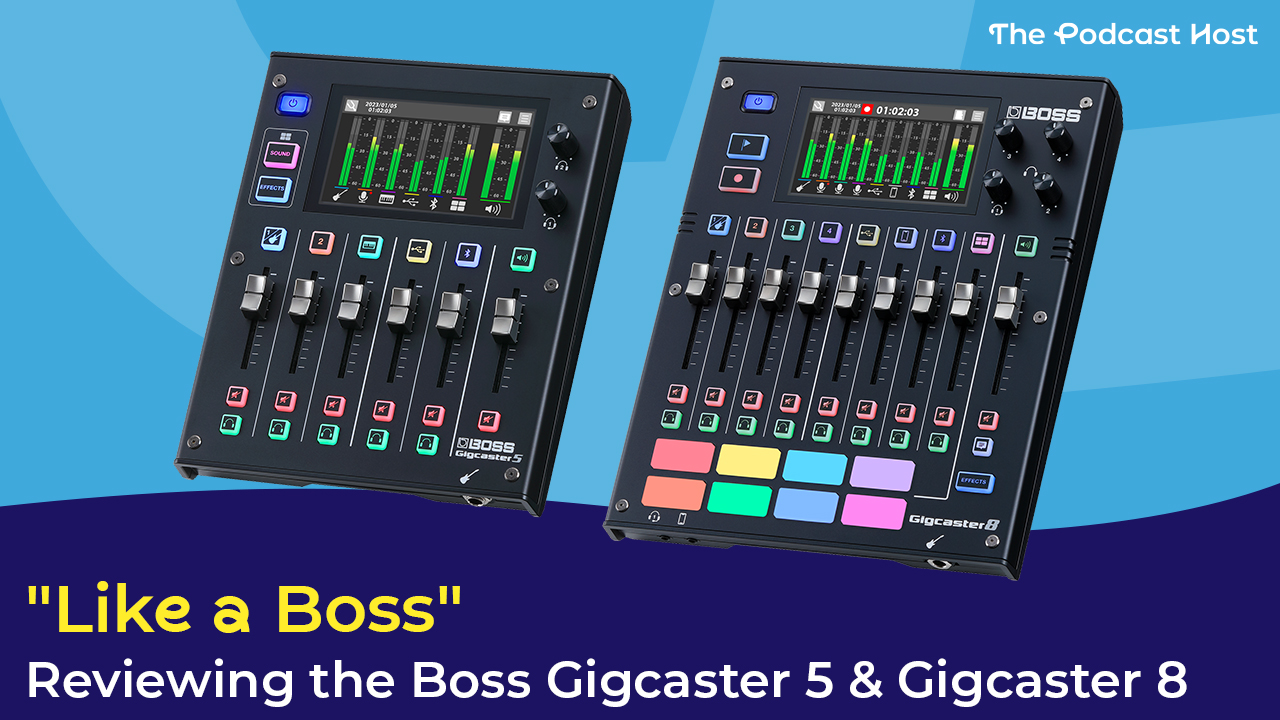
In my past life as a gigging musician, Boss was the most frequent brand I’d see on guitar and bass player pedal boards. They have a reputation for sturdy, high-quality effects pedals. I spent the best part of five years using their loop pedals as a busker. So being asked to review a Boss product as a podcaster, streamer, and general audio gremlin felt like something of a homecoming.
Today I’m going to be reviewing two of Boss’s (Boss-sus-susses?) offerings for audio streaming mixers designed for musicians, streamers and, most pertinent to TPH readers, podcasters. I’ll specifically be looking at the Boss Gigcaster 5 (£419/$459 on Amazon) and the Boss Gigcaster 8 (£549/$699 on Amazon) and testing them in a couple of different settings.

Editor’s Note
The two Boss Gigcaster units were provided for review purposes. We use affiliate links in this review and would earn a small commission should you choose to buy through them. Affiliates help support our free content, though they never cloud our judgement or prevent us from giving you our honest opinions!
Boss Gigcaster 5 vs Gigcaster 8 – More tracks, more buttons!
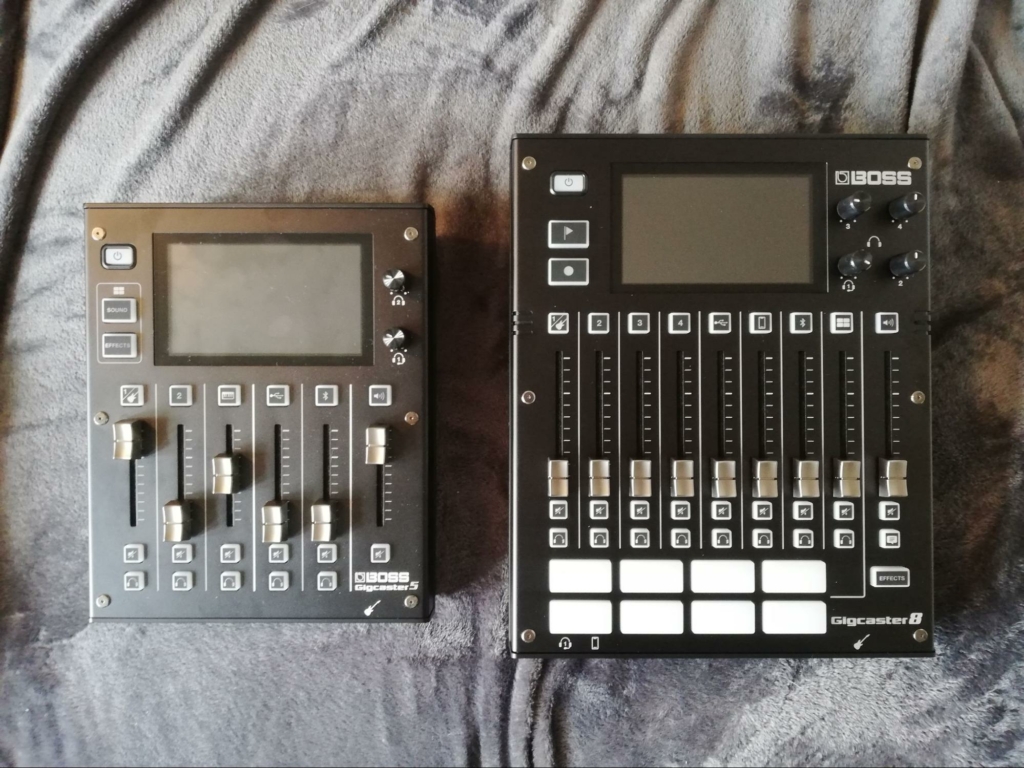
For the most part, the differences between the two mixers are straightforward.
- The 8 has eight tracks, while the 5 has five (I’m sure that’s a coincidence).
- The 5 has two XLR inputs and a stereo line input, while the 8 has four XLR/line combi inputs.
- The 5 has two headphone outs, while the 8 has four.
- Basically, the more expensive one is bigger and has more inputs and tracks!
So, What do they both do?
Both the Boss Gigcaster 5 and Boss Gigcaster 8…
- feature the option for Bluetooth and USB connectivity
- can be used as a USB audio interface
- have 48V phantom power
Both units also feature separate output levels for each headphone output, as well as mute and isolate buttons for each track. There’s also a talkback feature. This lets you use the built-in internal microphones to communicate through the headphones without going through the main output, a feature that is very handy for live radio or streaming environments.
Boss Gigcaster Quick wins
Both units also come packed with Boss effects based on the incredible GT-1000 effects board, which includes EQ and mic treatments, with a healthy number of presets to get started with. I initially set up my microphone with the ‘Calm Speech’ setting and left it basically unaltered during my testing time. If you’re not one for post-production (otherwise known as ‘a healthy normal person’) or you have a quick turnaround time for episodes, this cuts down the time required for editing by treating and mixing your audio at recording, rather than something that has to be figured out later.
Monitoring
The headphone outputs are 3.5mm jacks like the headphone jack of your phone, which I thought was odd. Usually, for mixers like this, you’d find the larger, much heftier 1/4-inch headphone jack. It’s not a big difference for me; it just meant I had to use an adapter. It’s an unusual choice for something aimed at audio creators of all stripes.
Wait… more differences?
Aside from price, size, inputs, and tracks, there are a couple of other interesting differences between the two mixers. The Gigcaster 8 has eight touch pads (again, a coincidence, I’m sure) to trigger sounds and effects, while on the 5, the same functionality is controlled via the touchscreen after pressing the ‘Effects’ button. The Gigcaster 8 also has a dedicated input jack for a device such as a phone or tablet, providing another option for recording audio.
The biggest difference between the two mixers is that the Gigcaster 8 has the ability to record to an SD card directly from the mixer, making it ideal for recording on the go. There’s even an option to record in multitrack for easy editing post-recording. With its four mic inputs and four headphone outputs, I think the Gigcaster 8 would be a great choice for recording on the go or a setup for people who don’t want to invest in a work computer for handling audio.
Using the Boss Gigcaster 8 as a USB interface
Any tech that requires me to unplug my trusty and beloved Focusrite Scarlett 8i6 will always make me nervous. However, the Gigcaster 8 proved an excellent studio recording companion.
While the setup was a little confusing, it was no more of a challenge than setting up an unfamiliar USB audio interface usually is. But thankfully, Boss have uploaded a comprehensive Quick Start tutorial series on their Youtube channel. I was ready to go after watching their video for setting the Gigcaster up for streaming.
I didn’t have much opportunity to put all eight tracks through their paces. In the end, I just plugged in my desk mic and my Moog Grandmother synthesizer. I was more interested to see how it fared as part of a workflow.
I think the advantages of using the Gigcaster as a USB interface are more relevant to musicians rather than podcasters. I found a lot of Youtube videos singing its praises as a mixer for live-streaming musicians, and I think if my own streams were more based on live performance rather than composing, I’d get a lot out of the Gigcaster (maybe that’s something to try in the future). The fact that it doubles as an effects box and has an in-built tuner makes it particularly good for guitarists and singers. The control over individual parameters with the touch pads and individual track volumes with the faders also makes it incredibly handy for looping musicians of all stripes.
For straightforward audio recording, it kind of does what you would want a USB mixer like this to do. You can assign different inputs to different tracks in your DAW or record the main output. You can adjust the sample rate without anything breaking (always a plus). And having the ability to control the audio level with the faders and use the Gigcaster to add effects such as EQ and compression before going into the computer is great for streamers and podcasters with quick turnaround times.
It also just…looks good on a desk…if that’s the kind of thing you like…
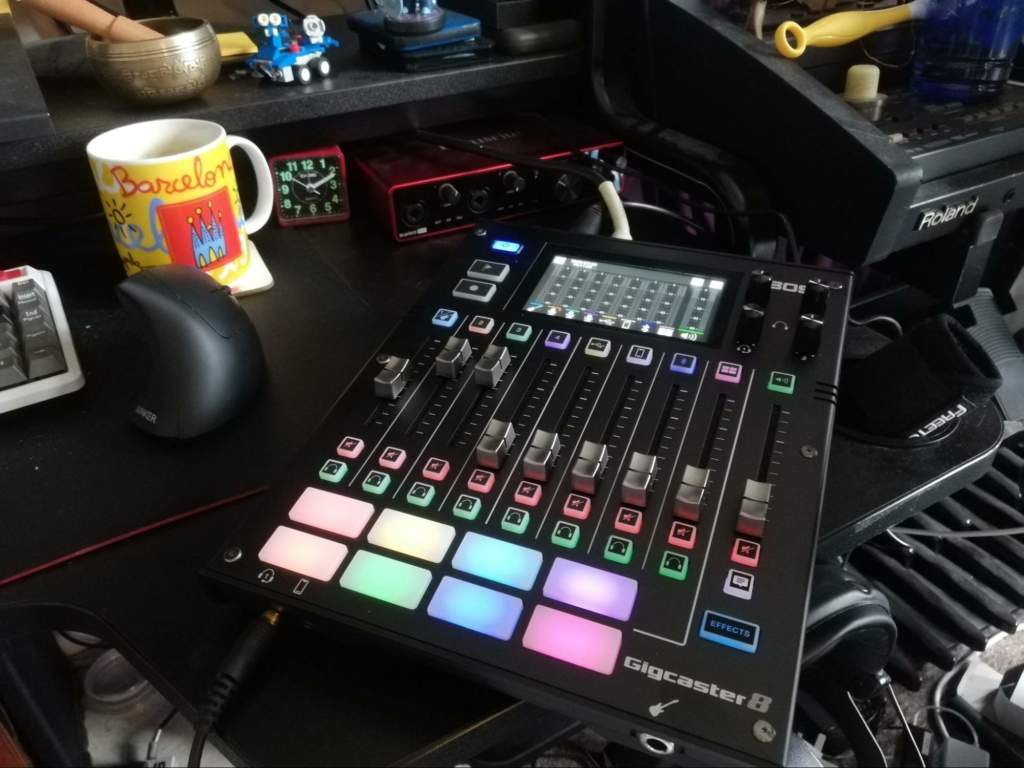
Comparing it to my usual interface (Focusrite Scarlett 8i6) just on recording alone, I liked having more tactile, physical control over levels with the faders. I have dials on the Scarlett for the two main inputs, but the other four inputs are straightforward line inputs. Those have to be adjusted with the Focusrite Control app, which uses the mouse. If you read my controller article, you know this isn’t my favourite thing to do.
I think the Scarlett is easier to use as a straightforward USB interface and took much less time to figure out than the Gigcaster. Granted, the Gigcaster is more complex and has more features and use cases. But if you’re looking for an audio interface for recording podcasts into your computer, a lot of those features might not necessarily be what you need.
Using the Boss Gigcaster 5 for live performance
The timing of this review provided an interesting opportunity to test the Gigcaster in a field I feel isn’t often discussed in podcasting: live performance.
As it so happens, I am in the process of developing a live set based around some of my audio drama work, using Roman Mars’ 99% Invisible TED talk as a starting point. With this in mind, I thought it would be interesting to switch out the so-old-you-can’t-buy-it-anymore analog mixer I got for free when my partner’s work was having an equipment clear out with the Gigcaster 5 and see what happened.
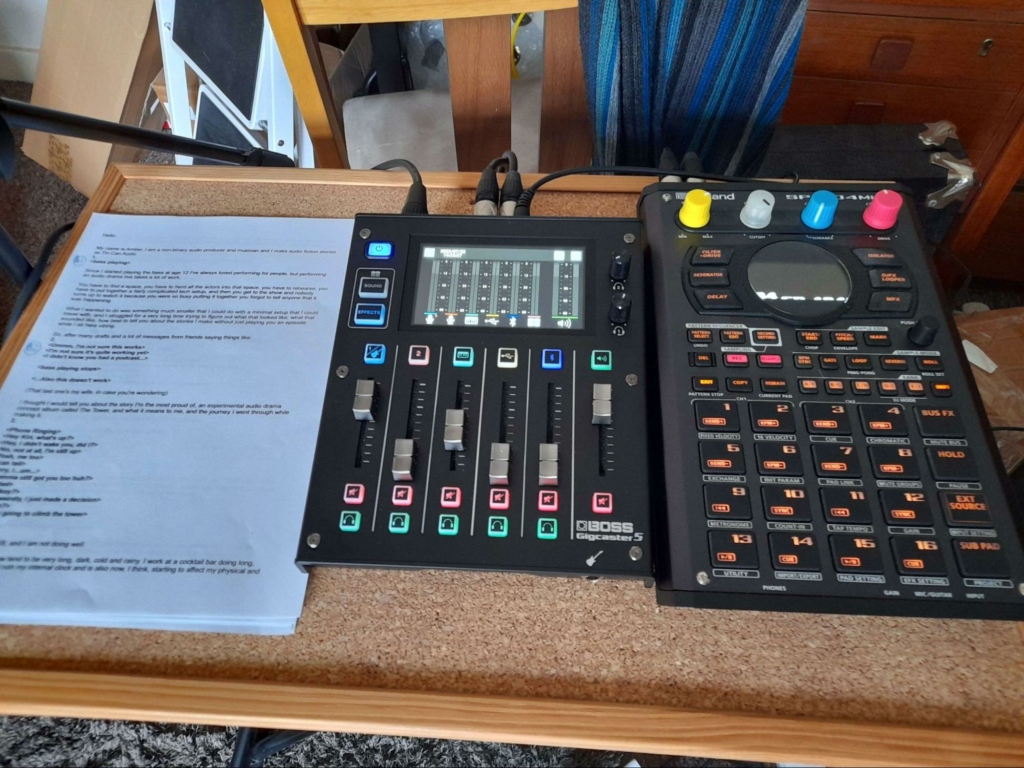
To give you a quick rundown of the setup here: I have a Roland SP404 MkII (‘The Magic Box’) that I use for music, sound effects and voice clips, going into the stereo input of the Gigcaster 5. My microphone is running into the first mic input.
The twin headphone ports mean I can not only monitor levels without needing an external sound desk, but it also means I had a line out to record performances onto my Tascam DR40. This already simplifies what in the past has proven to be an often complicated process involving routing and lots of wires. Having the recorder nearby and getting the same audio as both my headphones and the venue speakers is very, very important to me. The fact that Boss seems to have thought of this already endears me to the Gigcaster.
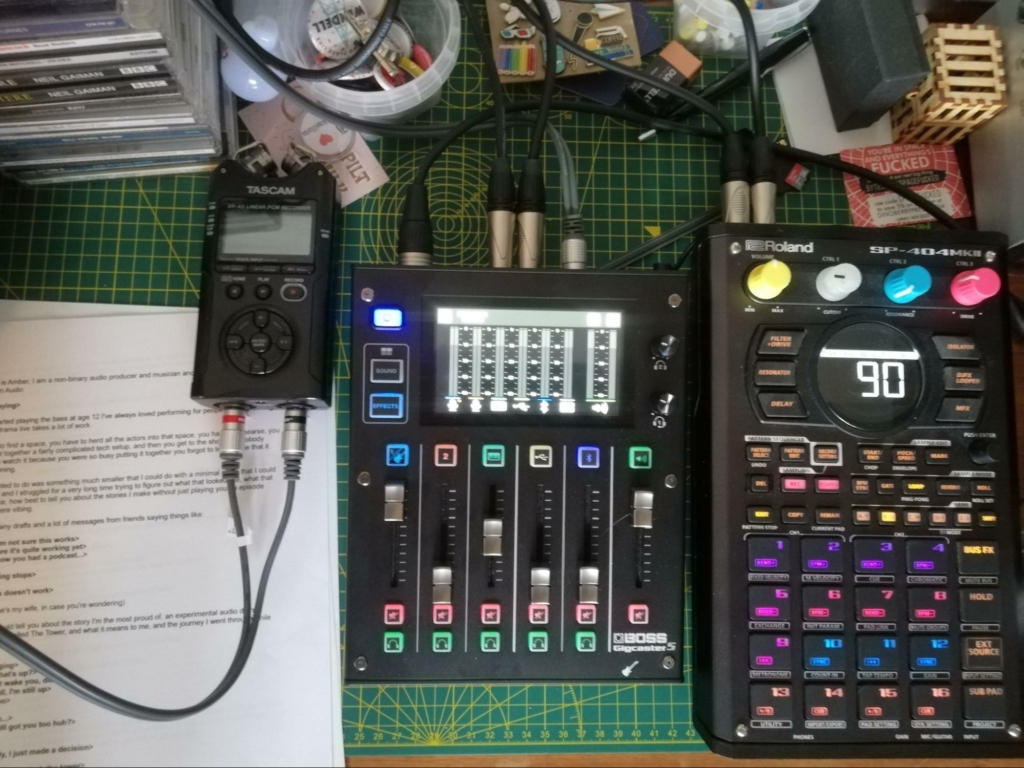
Getting going with a basic setup is intuitive and straightforward. It didn’t take me long to figure out how to adjust the settings on each track (there are already presets for ‘Talk’ and ‘Console’ setups). It’s clear what each button does: the mute and isolate buttons for each track are clearly labelled, and where you expect to find them under the faders.
To change the setup of each track, you press the button above the fader, which made sense to me. The effects button takes you to – you guessed it – the effects page, which gives you buttons on the touchscreen in a similar setup to the coloured buttons on the bottom of the Gigcaster 8. These buttons can be easily programmed to trigger effects or even play sounds, which is incredibly useful for live podcasting or audio drama performances.
The touchscreen itself can be a bit fiddly with the size of some of the onscreen buttons. Adjusting the input gain for tracks with tiny + and – buttons felt disappointing on a console with so many physical dials and faders. It is, however, very cleanly laid out, and you’re never more than one tap away from the home screen, which is, again, very handy for a live performance scenario.
I couldn’t quite get the effects working on my own, but once again Boss’s (Boss-ezz?) Quick Start video series saved the day, and after 5 minutes, I was playing around with all sorts of weird and wonderful effects.
Incorporating the Gigcaster 5 into my live setup was as close to effortless as setting up tech could be. Any problems I had were solved quickly, either through trial and error or by looking up one of Boss’s (Boss-ess-ess?) videos. I felt inspired using it, and it made me want to experiment and make more things, which I think is very impressive for a mixer.
In the world of indie audio drama, the idea of a live show can be a daunting and complicated affair. I think the Gigcaster series, at least in my case, makes that process a little less daunting.
Conclusions – Do YOU need a Boss Gigcaster?
So, here’s the thing. I love these mixers. In fact, I loved the Boss Gigcaster 5 so much as a live performance tool, I actually asked if I could keep it. For something as straightforward as a mixer, this series offers so much by way of effects and creativity in a way that is accessible and intuitive. Boss has gone out of the way to explain the possibilities of these units, with multiple playlists on Youtube demonstrating in detail how each facet works, and with hands-on walkthroughs for different mediums.
There are so many things I didn’t get to talk about in this review: I didn’t test the mixers in a streaming environment. I didn’t go in-depth about the soundboard features or the effects, or that you can pretty much control any parameter of the desk with a footswitch, which is a really cool feature that presents so many unique possibilities!
But, most podcasters don’t need an effects box, and most podcasters won’t need a soundboard. If you’re looking for a mixer to record interviews with, there are cheaper options out there, and a lot of them also double as hard-disk recorders.
That being said, if, like me, you work audio in multiple fields like streaming or music, or if your work in podcasting is a bit more niche like audio drama, creative non-fiction or live recordings, the Gigcaster series offers everything you could possibly need and more. Playing around with these mixers has already inspired me to experiment with new storytelling possibilities and new formats.
Check out the Boss Gigcaster 5 and Boss Gigcaster 8 on Amazon.
Our Rating: 4.8/5
- Ease of Use: 4/5
- Features: 5/5
- Versatility: 5/5
